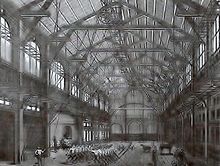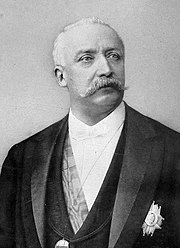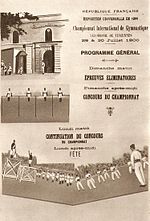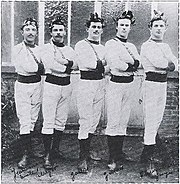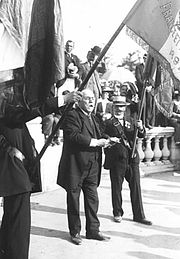Shipping from Europe with tracking number /45mm,Silver plated bronze ,Paris mint by Rivet
Union of Gymnastics Societies of France
| Union of Gymnastics Societies of France Homeland, Courage, Morality | |
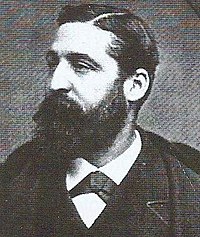 Eugène Paz , founder of the USGF . | |
| Acronym | USGF |
|---|---|
| Sport (s) represented | gymnastic |
| Creation | |
| Disappearance | |
| President | Eugene Paz |
| Affiliation | European Gymnastics Office International Gymnastics Federation |
| Clubs | 1,100 associations in 1914 |
| edit | |
The Union of Gymnastics Societies of France ( USGF ), founded onby Eugène Paz , is the organization that manages men's gymnastics in France until, date on which the French Gymnastics Federation (FFG) succeeded him.
Gymnastics, which developed in France in the urban bourgeoisie under the Restoration and the Second Empire , becomes a national issue to the beginnings of III e Republic . A gymnastics room owner, journalist and teacher at the Lycée Condorcet , was at the origin of the Union of Gymnastics Societies of France in 1873. This quickly benefited from the experience of Alsatian gymnasts exiled in Paris and the one of them, Jean-Jacques Ziegler, is at the origin of the first federal festival in 1878. This festival then becomes the main stake of the Union which elects each year its new management committee to carry out this operation.
From 1897, we witness a stabilization of the governing body N 1 which was chaired for 34 years by Charles Cazalet . A convinced social patriot, he quickly gave it a new dimension by relying on the success of the federal celebration of 1900, organized within the framework of the Universal Exhibition . Without renouncing republican and patriotic values, it is gradually leading the Union along the path of sports competition and international excellence by relying on the training of executives. When it left in 1931, the USGF found itself somewhat destabilized. In 1940, the Vichy government thewhich has developed in parallel since the previous war. The current FFG results from the application of these two measures.
Gymnastics before 1870
Even when it shares activities with them, such as tournaments of chivalry , gymnastics differs in its history and philosophy from the hedonistic and folkloric practices that prelude modern sport . As certain hieroglyphics and the history of the ancient Olympic Games show, among other things, it is in the preparation of the combatant and the religious rites that its distant origin must be sought. In the xvii th century, thinking about the needs of the emerging industrialization assigns a new social function: prepare future manual workers in their harsh existence. It's John LockeP 1 (1632-1704) which lays the foundations of this"functional" pedagogy 1 and of "work schools" P 2 , the idea of which will be taken up by Johann Heinrich Pestalozzi P 3 (1746-1827) and the German theoreticians of the ' Arbeitsschule . Quickly the health problems of the working population lead to attribute to gymnastics an additional function of prophylaxis . Pehr Henrik Ling P 4 (1776-1839) is the most representative of this last trend which also leads tomodern physiotherapy . From the end of xviii th centurygymnastics developed in Europe in three distinct places: Sweden with Pehr Henrik Ling, the Germanic countries with Johann Christoph Friedrich GutsMuths P 5 (1759-1839), and in particular the "Father of gymnasts" Friedrich Ludwig Jahn L 1 (1772- 1852) and Switzerland with Pestalozzi but also later the Austro-Hungarian Empire with Miroslav Tyrs (1832-1884) and the Sokol P 6 movement . It is still most often only a generalized physical activity for military or hygienic purposes. The first European federation seems to be the Swiss Federal Societycreated in 1832. It was followed by Germany in 1860, the Netherlands in 1861, Belgium in 1862 and Poland in 1867 B 1 .
In France, she appears at the start of the Restoration with Francisco Amoros L 2 . It then experienced a military development but also civil in the private and school gymnasiums of educational establishments. The gymnasium then becomes the meeting place of the urban intelligentsia P 7 and socio-political debates. A normal military gymnasium was created in 1852 and, in 1867, the Minister of Public Instruction, Victor Duruy , mandated a study mission on gymnastics in Belgium and in the German-speaking countries under the chairmanship of Doctor Hillairet 2 . Published onthe Hillairet report, in addition to its conclusions, lists gymnastics teachers in France. The real observation of deficiency that he draws up explains the decree of Victor Duruy which institutes thea “certificate of aptitude for teaching gymnastics” (CAEG) N 2 . On the associative side, Alsace is under the Second Empire a real laboratory whose experiences will be largely exploited by the associative gymnastics of the Third Republic . Since theJean-Jacques Ziegler organized in Guebwiller the first gymnastics festival in France and founded thethe Association of Alsatian gymnasts B 2 , a true regional gymnastics federation. He organized a second party in Colmar in 1867 then in Strasbourg in 1869. It was again he who was the linchpin of the first federal party in Paris in 1878 at Pré Catelan B 2 . However, the first French gymnastics society seems to have appeared in Lyon in 1842 B 3 . That of Guebwiller dates only from 1860 and it was followed in 1865 by that of Épinal , in 1867 by two companies from Reims then in 1868 by the Gauloise of Paris. In 1870, 25 gymnastics societies were listed across the countryB 4 .
History of the Union
The federal holiday, pillar of the Republic (1873-1897)
The disaster of 1870 completed the inclusion of gymnastics among the national priorities, mobilizing beyond the sole political sphere: in 1872, the Normal Military Gymnastics School in Joinville became a Gymnastics and Fencing School , opening up to the whole Nation and in particular the teachers who have to do a three-month internship there during their military service. Eugène Paz, a teacher from the Normal School of Auteuil N 3 , who actively participates in this movement, founded the USGF the3 . The newspaper Le Monitor de gymnastique that he created in 1868 then became Le Gymnaste B 2 , a title that the federal review of the French Gymnastics Federation still carries to this day, and the motto "Patrie, courage, moralité" is adopted by the new union which thereby marks its commitment to national recovery after the defeat against Prussia and the drama of the Paris Commune . Two years later the USGFalready brings together 250 associations. But the public authorities are still reluctant in the face of associative initiatives which remind them of the Municipality. Paz, torn between the need to reassure them and the activism of the revengeful Alsatian refugees who reproach him for his moderation, must give way to B 5 and the presidency then changes every year at each Federal Festival to be organized.
In 1878 the new president Jean-Jacques Ziegler, mentor of Joseph Sansbœuf , organized the 16 anda great celebration of national regeneration chaired by Jules Simon L 3 . From this date the Federal Holiday takes place every year and the election of the Federal President changes every year until 1897 according to its organization 4 . Among the most illustrious of them are Félix Faure in 1880 and Joseph Sansbœuf 5 , founder with Paul Déroulède , Armand Goupil and Henri Martin of the League of Patriots 6 . Sansbœuf was then the only one to serve two consecutive terms in 1888 and 1889. By meeting before the President of the Republic Sadi Carnotmore than 10,000 gymnasts from 830 foreign and French companies in 1889 in the XV th federal party in Paris polygon Vincennes 7 it finally sealed the alliance between the gymnasts of USGF and the French State. From this date the successive Presidents of the Republic often honor the federal holiday with their effective presence L 4 and the gymnastic societies are “authorized to parade behind the troops with their music and flag” 8 .
The grip of gymnastics was further accentuated at the end of the decade with the creation of school battalions by Aristide Rey 9 . At its 1881 congress the League of Education of Jean Mace supports the approach and Paul Bert , Minister of Education, establishes the obligation to gymnastics and military exercises in elementary school by the law of. Finally, the, the cause of gymnastics received the support of the League of Patriots from its foundation. The initiative was formalized in 1883 with the appointment of an appointed inspector general, Pierre Joseph Jeanningros . The USGF has already acquired a European dimension and, with the Belgian and Dutch federations, it participates in theunder the chairmanship of D r Death to the founding of the Office of the European gymnastics federations which in 1922 became the International Gymnastics Federation (FIG). From 1891, when the school battalions disappeared, many were transformed into associations which reinforced the strength of the USGF 10 .
The turn of the century
Until the dawn of the xx th century , the USGF is mostly a reflection body whose steering committee is proud to count among its members leading scientists, political, literary and media of the moment. And if the USGF is fully involved in the organization of its big annual federal celebration intended to mobilize energies in the service of the nation 11 and soon relayed by local initiatives in the provinces, it remains at the very least reserved towards of sports competition, as also the European office chaired by the Belgian Cupérus L 5 who isin 1896 B 6 , year in which Charles Cazalet became president of the USGF . This position is confirmed by the participation of a single Frenchman in the same Games. During the following in Paris, gymnastics is, along with cycling, the most popular sport in France and at the center of sports education in the Third Republic . It is therefore up to USGF N 4 to inaugurate the brand new Vincennes velodrome on 3 andby its federal holiday 12 with 8,050 gymnasts from all over France. In the process, in the international competition organized on 29 andwithin the framework of the universal exhibition and won by Gustave Sandras L 6 , the French gymnasts who represent the majority of the participants obtain the first 17 places. Thethe competition of the Association of Gymnastics Societies of the Seine closes the gymnastics festivities.
Charles Cazalet intends to perpetuate the acquired advantage. The following year he invited the painter Octave Denis Victor Guillonnet to the federal festival in Nice on the 7th and. This one sees 3,000 gymnasts parading in front of Gambetta's tomb to pay him a solemn tribute that Guillonnet immortalizes on a canvas. Cazalet obtains that the work is etched and reproduced for wide distribution. The objective is clearly displayed in his letter ofto Étienne Dujardin-Beaumetz , Under-Secretary of State at the Ministry of Fine Arts: “propaganda prints which would serve, I believe, admirably the patriotic cause to which we are attached; the memory of this great event, the ideas it evokes, the memory of Gambetta and national defense are all forces of influence to further increase the patriotic and republican feelings of all our youth ” . These reproductions enjoying great popular success that endures and for the 42 th Congress of the USGF 1920 in Nice, the Paris daily Le Petit Journal again for its “front page” this painting by Guillonnet, which has since entered one of the great classics of sports and republican painting.
A pre-military sports organization (1900-1914)
This success changed mentalities, but it was not until 1903 before the first international tournament was organized under the aegis of the European office in Antwerp where France took first place by team 13 . The same year the USGF is recognized of public utility on. Building on these successes Charles Cazalet, vice-president of the European office and future president, already favorable to the competition, took charge of the following tournament in Bordeaux in 1905. France did it again 13 : the USGF entered the sporting era. For ten years, France contested the first place with Bohemia , never finishing below second place between Antwerp (1903) and Paris (1913) L 7 . Individually Josef Martinez , Marcel Lalue and Marco Torres each take the top step of the podium, twice for the last 14 . The USGF also invests theColonial Empire - Jean Jean Latte in his book quotes Algéria-Sports L 8 and the Dakar Tricolor L 9 among the large associations of the Union - and it organizes its federal festival in Algiers from 1896 L 10 then in Tunis in 1912 L 11 . North Africa then provided him with his greatest champions: in addition to the world champions Joseph Martinez and Marco Torrez d ' Oran already mentioned and Louis Ségura de Sidi-bel-Abbès N 5 we also note the internationals Castelli and Ben Sadoum also of l ' Oranaise and Chrech d'Alger.
The USGF pays great attention to the training of its executives, often from the Joinville School . In order to provide them with higher-level training, in 1903 it financed the Higher Physical Education Course L 12 created at the Sorbonne by Georges Demenÿ , assistant to Étienne-Jules Marey at the physiological station of the Parc des Princes B 7 . This course foreshadows the university integration of teacher training. However, the major objective remains patriotic and the USGF , which brings together 1,100 associations on the eve of the Great War, largely contributes to providing the nation with the soldiers it hopes L 13 to ensure revenge. It was then exclusively male and the French Union of Women's Gymnastics Societies did not appear until 1912. In 1921, it became the Federation of French Women's Gymnastics and Sports Societies (FSFFGS) and became theof the same year in the French Women's Federation of Gymnastics and Physical Education (FFFGEP) 3 . Since 1906, gymnasts have enjoyed many advantages during their L 14 military service when they hold the B 8 Military Aptitude Certificate . Also and to this end the program of its competitions remains mainly collective and very eclectic B 9 . The titles of champions are decided as much with the pole vault or the lifting of pigs as with the fixed bar L 15 ; even at the world championships this will persist until 1954. Only the tournaments of the Olympic Gamesare limited to only gymnastic practices on apparatus. Thanks to this multidisciplinary physical excellence, gymnastics provided the Army with many of its executives and a large part of its elite troops during the 1914-1918 war, from which it emerged strengthened while the Union of French Athletic Sports Societies ( USFSA) dissolves through the new single sport federations.
The interwar period and Vichy (1919-1942) [ edit | modify the code ]
The Union lost 100,000 of its members and cadres during the conflict 15 . But it nevertheless organizes a large national rally inin Nancy to celebrate the return of Lorraine and Alsace to France L 16 . The international results fell a little and France fell back to third place at the 1922 Ljubljana international tournament . However in 1924, during the Paris Olympics, it rose to second place in the world ranking to fall back to third at the Lyon tournament in 1926. The humanist and social tradition continues and Georges Hébert recognizes that same year that the executives of gymnastic societies have “a past, traditions and the awareness of being useful to the public good” .
The Amsterdam Olympic Games in 1928 ended in failure, but the year 1930 marked a revival: the Union went back to second place at the Luxembourg L 17 tournament . The international tournaments gave way from the following year to the world championships, the first of which was organized in Paris in 1931. From that date, France downgraded regularly to the general classification L 18 . During this period the USGF remains a bastion of the republican ideal and the way in which it organizes its Federal Festival is a way of putting itself at the service of the regime whenever necessary: in 1929 in Orleans during the celebration in honor by Joan of Arcto support the will of the secular state to claim the character of the national heroine in 1930 in Algiers to celebrate the 100 th anniversary of the conquest of Algeria L 19 and the following year in Paris for the Colonial Exhibition international Paris .
However in 1923 the conflict which opposed for 20 years the USGF to Philippe Tissié and his medical colleagues - who challenged him the monopoly of the higher training of the teachers of physical education - turned to its disadvantage: the higher course escapes him 16 . It then refocused on that of the gymnastics executives of its associations and from 1927 the Union organized an annual course for civilian instructors in Dinard L 20 . In 1931, Cazalet, tried by his professional setbacks, left the presidency and died two years later. The presidency fell to Gaudier (1931-1937) who was succeeded by Wachmar (1937), Manchet (1938) then Colonel Lecocq (1939-1942) L 21 . The, a merger was imposed by the Vichy regime between the USGF and its female equivalent, the French Federation of Gymnastics and Physical Education (FFFGEP). The new entity created by this merger takes the name of Fédération française de gymnastique (FFG) and the instructor course from Dinard is moved to Saint-Maur L 20 .
The Federal celebrations
Celebrations of national regeneration
A first event intended to mark the birth of the Union was organized in Paris in 1875 at the Pré Catelan B 10 . But the Federal Holidays did not really begin until 1878, 5 years after the creation of the USGF . From this date and until Cazalet the presidency of the Union often merges with that of the organizing committee of the following festival. In 1880, for example, this was provided by Félix Faure , future President of the Republic and president of the company La Havraise, which took charge of the 1881 feast. True celebrations of national regeneration, according to the name given to the first, these demonstrations often have the support of the public authorities; Thus in 1882, in Reims, Jules Ferry , President of the Council , presided over the B 11 events . But it was up to Sansbœuf to obtain the crowning achievement with the effective and almost constant presence of the President of the Republic from 1889 7 when regional festivals multiplied in province B 12 . No record has been found for this period when the patriotic and festive gathering takes precedence over sports competition which remains very secondary.
| Years | USGF Presidents | Federal holidays |
|---|---|---|
| 1873 | Paz | |
| 1874 | Paz | |
| 1875 | Dean | Paris ( Le Pré Catelan ) |
| 1876 | From Jarry | |
| 1877 | Ziegler | |
| 1878 | Boggio | Paris ( National Regeneration Day ) |
| 1879 | Gallot | Lille |
| 1880 | Faure | La Rochelle |
| 1881 | Death | Le Havre |
| 1882 | Dozole | Reims |
| 1883 | Lecocq | Angouleme |
| 1884 | Merillon | Amiens |
| 1885 | Puiraddaud | Bordeaux |
| 1887 | Lemercier | Tours |
| 1888 | Without beef | Saintes |
The State involvement
From 1889, with Sadi Carnot , the President of the Republic himself often travels to the provinces to personally chair the large L 4 gathering . Raymond Barrull attests that his successor Félix Faure, former president of La Havraise and of the USGF , attends all the parties during his B 13 presidency, but Jean Latte only mentions this for the first and the last year. This honor continued until the declaration of war and Raymond Poincaréstill presides over the Rennes festival shortly before the outbreak of hostilities. Until the advent of Charles Cazalet, the festivals were above all popular and patriotic festivities. The individual winners take the title of champion of France from 1898 L 22 ; the first is therefore Vandeputte. Gaudier, laureate in 1891, succeeded Cazalet as president of the USGF from 1932 to 1936. The first collective rankings that we note are those of the Toulouse festival in 1893 which crowns La Longchamps de Bordeaux then that of Algiers in 1896 which saw the victory of the Arras Gymnastics and Weapons Society . We must then wait for the big federal holiday ofin 1900 to find a full list of achievements. That year, in the same enclosure of the Vincennes velodrome , the national title went to Martinez d'Oran onand the Olympic title to Sandras from La Patriote de Croix N 6 on the 29th and, The champion of France ending at the 7 th spot. He then won the first international tournament in Antwerp in 1903 L 23 and totaled 10 gold medals in 3 participations in the world championships from 1903 to 1907.
| Years | USGF Presidents | Federal holidays | Presidents of the Republic present | Team Champions | Individual Champions |
|---|---|---|---|---|---|
| 1889 | Without beef | Paris | Sadi Carnot | ||
| 1890 | Prud'homme | Besancon | Sadi Carnot | Langrognet and Schreb | |
| 1891 | Bourcart | Limoges | Sadi Carnot | Gaudier and Schitz | |
| 1892 | Lauras | Nancy ( first invitation of the Sokols ) | Sadi Carnot | Boivin and Dourthe | |
| 1893 | Plassan | Toulouse | Longchamps ( Bordeaux ) | Scherb | |
| 1894 | Parmentier | Lyon | Pillot | ||
| 1895 | Secrestat | Perigueux | Felix Faure | Buttin and Leleu | |
| 1896 | Hainedouche | Algiers ( at the initiative of Cazalet ) | Felix Faure | Gymnastics and Weapons Society ( Arras ) | Buttin |
| 1897 | Cazalet | Roubaix | Felix Faure | Schmitt | |
| 1898 | Cazalet | Saint Etienne | Felix Faure | Vandeputte | |
| 1899 | Cazalet | Dijon | Emile loubet | Low | |
| 1900 | Cazalet | Paris ( Universal Exhibition ) | Emile loubet | The Patriot ( Cross ) | Martinez (Oran) |
| 1901 | Cazalet | Nice ( Gambetta Celebration ) | Emile loubet | Lalue (Limoges) | |
| 1902 | Cazalet | Le Mans | Emile loubet | Company of the company Solvay ( Dombasle ) | Martinez (Oran) |
| 1903 | Cazalet | Marseilles | Emile loubet | Boroïllotte ( Valentigney ) | Martinez (Oran) |
| 1904 | Cazalet | Arras | Emile loubet | La Belfortaine ( Belfort ) | Dejagere (Tourcoing) |
| 1905 | Cazalet | Bordeaux ( Gambetta Celebration ) | Emile loubet | Gymnastics and Weapons Society (Arras) | Lalue (Limoges) |
| 1906 | Cazalet | Tourcoing | Armand Fallieres | Gymnastics and Weapons Society (Arras) | Rolland (Haumont) |
| 1907 | Cazalet | Clermont-Ferrand | La Belfortaine (Belfort) | Rolland (Haumont) | |
| 1908 | Cazalet | Troyes | Company of the Solvay company (Dombasle) | Lalue (Limoges) | |
| 1909 | Cazalet | Angers | Company of the Solvay company (Dombasle) | Martinez (Oran) | |
| 1910 | Cazalet | Saint-Quentin | L'Étoile ( Armentières ) | Lalue (Limoges) | |
| 1911 | Cazalet | Caen | Armand Fallieres | Youth ( Tourcoing ) | Dumont (Charenton) |
| 1912 | Cazalet | Tunis | La Gaillarde ( Brive ) | Torres (Oran) | |
| 1913 | Cazalet | Vichy | The Frenchwoman ( Avize ) | Torres (Oran) | |
| 1914 | Cazalet | Reindeer | Raymond Poincare | The Future ( Thaon ) | Aubry (Suresnes) |

